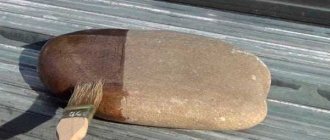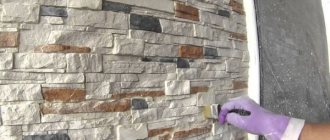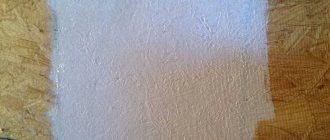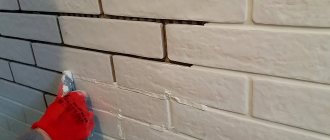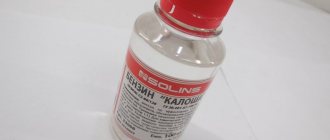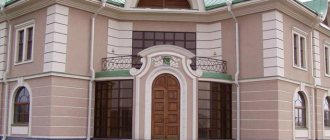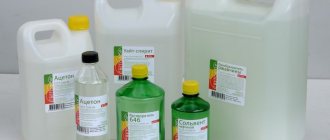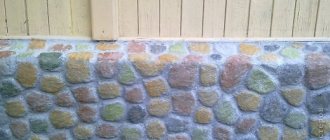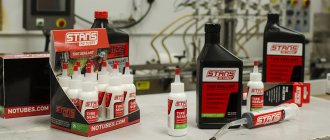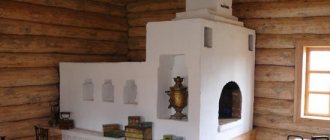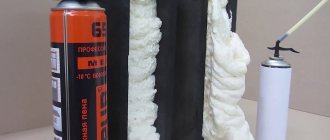Varnish is applied to stone bases in two cases. To protect this material from deformation and damage due to the influence of environmental factors.
And also to make a unique external vision.
Varnish with a wet stone effect is in great demand, both inside and outside the building.
The chemical composition of such a substance has high technical indicators and parameters, otherwise the whole work will simply fall apart.
More detailed information about this paintwork will be given below.
Master class on creating the “wet stone” effect
Walking along the city streets in rainy weather, each of you probably noticed how the facades of natural stone buildings, wetted by raindrops, are transformed. When soaked in water, they become brighter and more picturesque than they really are, and their reliefs and texture patterns created by nature begin to appear in a completely different mood.
But, alas, on soft types of natural stone, such as limestone, sandstone, travertine and marble, the atmospheric phenomenon described above does not “affect” at all, but, on the contrary, has a detrimental effect. After all, the listed types of natural stones, saturated with moisture and saturated with salts, begin to gradually become covered with microcracks and collapse.
However, today a highly effective method has been invented that allows you to obtain the “wet stone” effect by fixing it for a long period of time. This method consists of using any product, the main ingredient in the creation of which is fat.
Today's markets offer a wide range of different chemical impregnations that make it possible to achieve the effect of a wet surface on natural stone. Since these compounds differ from each other in their component composition, the results of their action also differ.
While some emulsions create the thinnest “wet” film on the outer surface of the rock, others, penetrating deep into the material, clog most of its pores and polymerize them, forming a “raw” effect. The second option is the most preferable, and this is what we will recommend to you today, since, unlike the first, it does not “evaporate” over time with regular care of stone products.
A product for imparting a “wet effect” to various types of natural stone (limestone, “Tree Bark” slate, lemezite, sandstone, sawn granite, etc.) is called “AGER”. This coating of a fluid consistency emphasizes the natural color and structural structure of the stone product and at the same time has a transparent or opal tint.
The required amount of AGER liquid is determined based on the type, porosity and size of the stone “body”, however, according to the instructions for use, for processing 25-30 sq.
Types of decorative and protective coatings
Modern decorative and protective compounds intended for coating stone penetrate into microcracks in natural materials, filling them, preventing moisture from penetrating inside, and repelling water. The choice of such a product primarily depends on the functional characteristics of the stone or tile.
Wet stone effect varnish
There are a huge number of impregnations that differ in their chemical compositions and physical properties. These substances are very popular in the construction industry. For decorative finishing of natural stone, varnish is used. A specific protective film is formed on the surface of the mineral composition.
The surface of a natural material treated in this way acquires a distinct color saturation, and moisture does not get into the microcracks of the surface. Saturation can be achieved through simple finishing procedures, simply applying the varnish to the surface with a paint brush.
A varnish with a “wet stone” effect must be chosen correctly, taking into account the operational characteristics of the stone. Otherwise, you may not get a high-quality and long-term effect. Features of choosing a varnish to create a wet effect:
For exterior work, special varnishes with enhanced functionality are used. The product must withstand temperature changes, increased mechanical stress, precipitation and ultraviolet rays as efficiently as possible. Using such means you can treat the surface of paving slabs and a façade lined with brick.
Finishing stone indoors requires minimal protection. The main thing is that the varnish can withstand the microclimatic conditions of the room. This composition is suitable for tiles in the bathroom or natural stone, decorative columns in the corridor, hallway.
Acrylic varnish has universal properties. If acrylic is water-based, then it is better to use it indoors, on a surface with minimal mechanical impact. Solvent-based acrylic varnishes are suitable for external finishing work, as they are characterized by increased toxicity and durability.
It is not advisable to treat sidewalk surfaces with varnish. Varnish is best used for painting facades, columns, and finishing elements of a building. Otherwise, you will have to frequently restore the surface.
In the video: using an organic-based wet-effect varnish.
Impregnation with high mechanical load
For paving slabs or tiles that are laid indoors on the floor, special compounds are used. Most often this is an impregnation with a wet stone effect. It is not recommended to use conventional dyes - this can spoil the mineral complex of the product.
Features of impregnation for paving made of natural materials:
- simplifies the procedure for maintaining the base;
- increases the service life of the coating;
- seals seams and joints between tiles;
- impregnation is used as an anti-slip agent;
- does not expose the surface to mold and mildew;
- wet-action impregnation is not exposed to aggressive chemicals.
During the processing process, it is necessary to fulfill a lot of conditions in order not to damage the building material, to make it more durable and aesthetically attractive. Thus, paving slabs and indoor tiles must be of a special type, since not all surfaces can be impregnated or covered with this type of varnish.
In the video: water repellent for granite slabs EC-77 - wet effect and protection.
No. 4. Criteria for choosing paintwork materials
The choice of the most suitable coating composition depends on the place of its application. When working with external walls, building facades and street structures (gazebos, fences), it is necessary to give preference to products with an increased level of moisture protection and resistance to UV rays. Also, such varnishes should look impressive on brickwork without losing their decorative functions during seasonal rainfall.
Other requirements are put forward for compositions for fireplaces and stoves:
- No toxicity. The varnish should not have an unpleasant odor, since when heated, dangerous toxins can be released.
- Heat resistance. For coatings of fireplace structures, only specialized compounds that are fire-resistant should be used.
To cover interior brick walls, it is better to give preference to acrylic or silicone compounds. The choice of such varnishes is large enough to choose the most profitable option.
When is impregnation necessary?
Many people forget to protect the surface and then reap the negative consequences. It is better to spend money once and carry out the treatment than to see after several years that the surface has lost its color and has become less presentable. Protective substances are needed in the following cases:
Use of stone both outside and inside the room. Both internally and externally the material is influenced in various ways. Outside, these are ultraviolet rays, temperature changes, precipitation and high humidity. Inside, the stone is exposed to moisture; solutions with a caustic composition or household chemicals may come into contact with it. There is water inside too. Therefore, stains may form on the surface of marble or other stone or the material may begin to deteriorate. Don't forget about mold, moss and mildew. As such organisms grow, they simply begin to destroy the structure of the stone, making it ugly and fragile. The stones contain salt. Under certain conditions, salt from the inside begins to come out. There it crystallizes and also negatively affects the stone, destroying it.
There is a wet effect impregnation for stone on sale, which not only protects the material, but creates a beautiful wet shine effect on the surface. The material becomes more rich and presentable.
These factors tell us that impregnation of the material is simply necessary if it is necessary to extend its service life, decorate it and make it reliable.
Protecting natural stone from graffiti
Recently, graffiti has become widespread. Some works can even be called objects of art, but basically these attempts to express themselves look like hooligan antics. Most graffiti paints are very difficult to remove from the surface of stone. To achieve results, you have to try several means. To avoid these difficulties, it is better to protect the surface of natural stone from paint penetration in advance, using products marked “anti-graffiti”. Stone treated with this product does not absorb paint, and it can be easily washed off with water and household detergents.
No. 5 Recommendations for applying varnish to a brick base
When deciding to use coatings to protect and decorate brick walls, it is important to remember that in order to obtain the desired results, you should not only choose the most effective product, but also observe all the details of the coating.
Varnish can be applied to walls in various ways: using a brush, roller or spray gun. Manufacturers insist that the composition should be applied in several layers (at least two). In addition, it is important to follow several important recommendations:
- The varnish should be applied at a temperature not lower than 10 and not higher than 30 degrees.
- Each applied layer requires time to absorb and dry.
- It is possible to coat a brick base with varnish only after preliminary treatment of the material.
Sequence of work
- Preparing the brick base. The wall must be thoroughly cleaned of old paint, dirt, and dust. This can be done using a hair dryer and solvent. Excess cement can be knocked off with a hammer or chisel. Small cracks can be filled with putty, and then the surface can be sanded with sandpaper.
- Cleaning from dust and dirt. You can wash the base using household detergent. This is necessary to remove salt stains, dirt and dust. After cleaning, the wall needs to dry.
- Application of deep penetration primer. For greater efficiency, it is better to use the primer from the same company as the varnish. It can be applied with a brush or roller.
- Varnishing. Using a roller (pile length 2 mm), a spray bottle or a nylon brush, you can begin to coat the wall with varnish. The composition should be applied from top to bottom.
- Consumption. As a rule, to apply one layer per 1 m2 you will need 100-200 grams of varnish.
The ideal time for varnishing is the warm season and low humidity. This will allow the solution to lie more evenly, without streaks. Drying time for each layer is 1-2 hours, for quick-drying compositions - 30 minutes. It will take 1-2 days for the finishing layer to dry.
To select the most suitable coating material, it is important to consider the following factors: place of application, protective characteristics, manufacturer, drying speed, decorating effects, cost, service life. Monitoring prices and features may take you some time, but as a result, you can be sure that your walls will last for many years without losing their aesthetics and functionality.
Types of varnish for wet effect paving slabs, and which one is better?
Wet effect tile varnish gives the coating a rich color, emphasizing the texture of the material. For surface treatment, water-based and solvent-based acrylic varnishes are considered.
Water-based varnish is more often used for interior decoration because it is non-toxic and does not have emissions harmful to the body.
The main advantages of processing varnish with a wet effect
Caring for paving slabs is no less important than caring for floor coverings in the house, since timely treatment of paths solves problems such as:
- abrasion;
- wear resistance;
- moisture resistance;
- aesthetics.
A coating treated with varnish that has a “wet effect” property will last longer, receive an additional matte shine and will look wet in dry weather, which will give the design of the paths an unusual look. In addition, tiles with a wet effect will be safer to use due to their anti-slip properties and will retain the natural shade of the material longer.
Types of varnishes
Impregnations and varnishes for stone and brick “wet stone” and with other effects can be divided into groups according to composition:
- Polyurethane varnishes. This is the most common type of surface coating. Varnishes have good hiding power, penetrate evenly and deeply into concrete and natural stone, reliably protect it from destruction and the formation of efflorescence by maintaining the level of internal humidity.
- Acrylic varnish for concrete is used in the construction and finishing of large buildings of medium and high comfort class. The compositions are highly effective, have low consumption, which leads to the high cost of the material.
- Water-based impregnations and coatings are among the most affordable. Two-component solutions are suitable for processing wood, concrete, and paving slabs. As a rule, these are colorless solutions.
- Latex emulsions serve as excellent primers for painting.
- Polymer impregnations for stone with a wet effect based on styrene have high wear resistance, which is their significant advantage. In addition, the varnishes are perfectly absorbed and dry quickly, which allows painting work to be carried out in any conditions. The solution of the domestic brand “Optimist” is popular.
The choice of composition is carried out mainly with a focus on the specifics of the solution: for interior or exterior work, for artificial or natural stone, with the effect of a wet surface or conventional impregnation.
How to use the protectant
The process itself is quite simple. It is similar to priming or painting a surface. Everyone can do all the work with their own hands. To do this, you need appropriate materials and tools, as well as step-by-step instructions and following the basic rules.
What will you need for the job? Application can be done in two ways: using a paint brush or a spray gun. It’s faster and more efficient to use a spray gun. With it, a large surface will be processed in a matter of minutes. However, not everyone can afford such equipment. Then a regular paint brush is used. Although it is harder and longer to work with it, the result will be good. So, the sequence is as follows:
Treatment of any surface must begin with its preparation. Marble, granite, plaster or other stone needs to be cleaned. Oil stains, tar, bitumen, salt, mold and debris are removed from the surface. To do this, special cleaning products are used. Depending on the type of substance used, the surface of the stone must be made dry or wet. For example, a silicone-based impregnation requires a wet surface to begin the reaction. Usually there are instructions on the impregnation that indicate the conditions under which the work must be performed. During use, chips and cracks may form on the stone. To make the surface ideal after treatment, all cracks and chips must be eliminated. Epoxy resin and sand-cement mortar are suitable for this purpose. If the cracks are small, they are sealed with a mixture of cement and sand. But for large cracks, professionals recommend using epoxy resin. Another important point: the impregnation must be suitable or compatible with the material being processed. This information can be seen on the packaging. To avoid damaging the material, it is recommended to perform a test application on an area that will not be noticeable. If no negative changes have occurred, you can begin full processing. The impregnation is used in the form in which you purchased it. It is prohibited to modify, dilute or change its structure. There is no need to pour it into another container either. Work with the container in which the impregnation was sold. Now everything is ready for application. Ideal working conditions: temperature about 11 degrees no less, humidity more than 67%. The composition is evenly applied to the surface in a thin layer. It is necessary to process the entire surface, without skipping any areas. When the surface of the stone is ready, you need to let it dry for 12–14 hours. It should not be exposed to moisture. The substance will acquire its true moisture-protective properties after 38 hours. But for 10 years it will protect the material from negative influences.
You also need to remember the safety rules during work.
It is important to do everything with gloves to protect the skin of your hands, as well as with glasses. If the composition gets on your skin, you need to quickly rinse the area with warm water.
In addition, when working indoors, it is important to ensure good ventilation.
Note! Remaining substances must not be stored. If the impregnation remains, it must be disposed of
No. 2. What are the composition of varnishes?
Brick varnish is a universal product for protecting the brick base. But in order for the varnish to lie evenly on the material and fully perform its functions, it is necessary to select it correctly, paying attention to its composition.
Polymer varnishes
This is the most popular type of paintwork. The demand for this product is explained by the versatility of its use. It can be used when working with brick and concrete foundations. Polymer varnish can be applied at sub-zero temperatures and in rooms without heating. It is easy to apply, dries quickly and reliably protects the material from scratches, cracks, moisture and dust. The mixture can be used to protect interior and exterior walls. Due to the ease of application of the polymer composition, it can be used by both professional craftsmen and beginners. Polymer varnishes are affordable.
Silicone acrylic varnishes
This type of coating is suitable for application to interior walls. The silicone-acrylic mixture can be used to coat not only brick, but also concrete, ceramic tiles, drywall, and metal. The composition is often used for application to decorative elements.
Thanks to the presence of special polymers in the mixture, the varnish can be of different shades. In addition to the protective layer, a wall treated with this composition can be transformed into any color, depending on your wishes.
Silicone acrylic varnish protects the base from alkalis, acetone, and oils. The only disadvantage of such mixtures is the price, which is significantly higher than their polymer analogues.
Polyurethane varnishes
This is a universal product that can be used to cover external and internal walls. It is polyurethane varnishes that create a “wet” effect on a brick base. They have excellent moisture-repellent characteristics, which is why they are most often purchased for treating external walls. The popularity of polyurethane varnishes is also explained by the fact that they can be used to treat not only brick, but also concrete bases.
Heat-resistant varnishes for fireplaces and stoves
This is a separate category of coatings, which differ in the characteristics of heat resistance and fire resistance. They are designed to prevent condensation from forming on the walls of stoves and fireplaces. Due to their high moisture resistance, such paints and varnishes are also purchased for decorating and protecting building facades.
Solvent varnishes
These compositions are based on silicone resin and solvents. When they penetrate the material, they create a strong protection, preventing cracking and loss of color. But at the same time, such varnishes are easily flammable, and it is necessary to work with them extremely carefully, observing safety rules.
Impregnations
In order to strengthen any paint and varnish, you can use special sealing impregnations. They are made on the basis of silicone and acrylic resins with the addition of aromatic, aliphatic solvents. Due to this composition, maximum protection of the paint and varnish for the brick base is ensured. When using impregnation, deep penetration of paintwork into the building material is guaranteed.
In addition, sealants create an additional protective layer from seasonal precipitation, chemicals and UV rays. Many manufacturers also offer decorated options with a “wet stone” effect. The negative side of such impregnations is that they can only be used for external or internal walls; they cannot be used when working with stoves and fireplace installations.
How to provide comprehensive protection
Reliable comprehensive road protection before putting it into operation provides not only a kind of “protective film” that guarantees high functionality in the future. It is ideal to do some of the operations before laying the tile covering, since the protective impregnation of the blind area is best done at this time.
Treatment of any type of road or sidewalk surface is divided into the following stages:
Preliminary cleaning of existing contaminants. It is produced using special detergents, which allows you to completely wash off not only dirt, but also various chemical deposits from the tiled or sidewalk surface. The older the road, the more complex pre-cleaning may be required. Application of hydrophobic composition. This will create the effect of a transparent water-repellent film. Even a road surface wet from rain or snow in this case will be less susceptible to the destructive effects of moisture
This is especially important for roads operating in difficult climatic conditions. Subsequent painting with decorative compounds, for example, special varnish. Allows you to get a beautiful “wet stone” effect, highlighting the natural color
Often used for paving stones made from natural materials that have become dull over time.
The same technology is used to “revitalize” roads covered with natural or artificial paving stones. If any type of road surface is just planned, it must be treated with a special impregnation before laying, which increases the frost resistance of concrete. This will prevent further destruction in the future due to low temperatures and constant penetration of moisture.
Instructions for use
Impregnation or varnish is sold ready-made. If a more liquid composition is required, the substance can be diluted with a regular solvent. To perform painting, you should additionally purchase a paint brush. A roller will not work, as it will not allow the substance to penetrate into the small pores of the material.
To prevent the stones from being damaged during processing, it is worth carrying out the work in accordance with certain instructions:
- The surface to be treated must be free of debris and dust. You can sweep the area, but the best solution is a vacuum cleaner. Very dirty areas will need to be washed.
- Be sure to dry the brick, stone or tile base, since the varnish does not stick to wet stone, and subsequently does not dry.
- Several thin layers of the composition are applied at regular intervals. If the previous layer has not yet dried, then the next one cannot be applied.
- Brick and porous tiles sometimes require several additional layers of coating. They also need to be applied evenly.
- Let the treated tile stand for a while so that the coating is completely fixed, saturating all microcracks and chips. The required time for fixation is two weeks.
As a result of quality work, a rich color is obtained, and the coating segments become wet. Thanks to impregnation, the conditions for using coatings and decor made from natural materials are improved. The mineral composition of the stone and its properties are preserved, and geodesy is improved. Any person who does not have special skills and experience in repair work can cope with the application of the material.
Popular hydrophobic solutions
One of the widely used hydrophobic solutions is Tiprom M, which provides good protection of the material from moisture penetration and ice formation. This impregnation creates a “wet” effect for paving slabs, improving their appearance. By using this water repellent, you can avoid covering with a protective layer of waterproof varnish.
Wet effect: example.
Rain or snow, when using this solution, can fall on the path and the quality of the protective coating will not be affected. Do not treat in areas where water is actively draining and where puddles are constantly forming.
The same manufacturer produces a deep-penetrating hydrophobic impregnating solution specifically for wet areas - “Tiprom K LUX”. Possessing all the qualities of the previous water repellent, this impregnation penetrates into pores (to a depth of 20 mm) and can be used under any operating conditions of the road surface.
Among the imported developments of hydrophobic coatings for paving slabs, we can note: Ceresit CT10, Impregnat Dry and VOKA. All of them have good water-repellent qualities, but are much more expensive than domestic compounds, which limits their widespread use.
Ceresit CT10 is a water repellent based on organic silicone. Provides comprehensive protection of the sidewalk surface, has a “wet stone” effect, creates a durable protective film from the first coating, has antibacterial and biological protection, excluding the appearance of mold and mildew.
Impregnat Dry is a liquid specifically formulated to protect concrete pavers. Guaranteed penetration, increases frost resistance and improves the appearance of the paved surface. Requires a two-layer coating.
Universal impregnation VOKA is characterized by increased water-repellent properties. Apply to the surface once and penetrate to a depth of 3 mm. The main advantage of this solution is its extended service life (more than 10 years).
Any, even the simplest hydrophobic treatment of a paved surface, provides protection for paving slabs, which will preserve its appearance and increase its service life. Creating protection should not be delayed. The sooner you carry out the treatment, the higher the chance of maintaining the integrity and appearance of the paving stones for a very long time.
Polyurethane wear-resistant one-component varnish for concrete, stone, brick and tiles
- versatility and ease of application
- high wear resistance and impact resistance
- chemical resistance and waterproof
- excellent decorative qualities
- ease of wet cleaning
- glossy
- in 3 hours - small order
- next day - big order
- 3-5 working hours days - for goods on order
- In Moscow within the Moscow Ring Road - from 500 rubles.
- In the Moscow region beyond the Moscow Ring Road - 500 rubles + 20 rubles/km.
- We deliver goods throughout Russia! We deliver free of charge to TK terminals (in Moscow)
More details
- Description
- Application
- Characteristics
- Documentation
- Reviews
Tistrom is a one-component polyurethane varnish of increased strength.
The varnish is a one-component polyurethane varnish, cured by air moisture, with increased abrasion and wear resistance characteristics.
Polyurethane varnish Tistrom is used to protect concrete, stone, paving slabs, concrete floors, floor tiles, paving stones, products made of natural and artificial stone, decorative stone and printed concrete, facing bricks.
Polyurethane varnish forms a strong, wear-resistant and durable coating. The varnish is resistant to gasoline, oils and other petroleum products.
The coating based on polyurethane varnish has unique properties - high compressive and tensile strength, chemical resistance, withstands high mechanical loads, and has the highest impact resistance. Coating with polyurethane varnish provides reliable protection and significantly extends the service life of the protected products.
Purpose
Tistrom polyurethane varnish is used:
- for the installation of thin-layer polymer floors,
- protective and decorative finishing of concrete and mosaic floors,
- screeds, paving and facing slabs,
- natural and artificial stone,
- decorative paving stones, borders, plinths
and other surfaces subject to abrasive wear.
Polyurethane varnish protects concrete from spills of acids, oils, petroleum products, salt solutions, solvents, and organic substances. The coating also protects the concrete from spalling and thermal cracking.
Due to its elastic properties, the polyurethane coating perfectly resists impact and scratching loads. Operating temperature of the coating is from -50°С to +100°С .
Tistrom polyurethane varnish is used for protective and decorative coating in garages, car service centers, parking lots, production workshops, warehouses, retail and utility rooms, agricultural facilities (poultry farms, cowsheds, etc.).
Attention!
- Supplied in lithographed containers!
- The label is equipped with protective elements against counterfeiting!
Mode of application
Single-component varnish, ready for use. Apply to a sanded, dry, clean surface with a roller or brush. If necessary, the varnish is diluted to working viscosity with xylene, toluene, or solvent.
Before varnishing concrete floors, the surface is pre-sanded. The concrete base must be clean, dry (base moisture content no more than 4% ), strong (compressive strength no less than 20 MPa , tensile strength no less than 1.5 MPa ).
Apply the varnish in the temperature range from +5°C to +30°C , in 1-2 layers. Drying between layers is 8-12 hours, but no more than a day.
Pedestrian traffic is allowed after 24 hours . Wheel load - after 3 days .
Consumption
Consumption of polyurethane varnish - 0.1-0.2 kg per 1 sq.m. depending on the type and type of surface.
Precautionary measures
When carrying out interior work, as well as after completion, thoroughly ventilate the room. Use personal protective equipment.
Storage
Do not heat. Keep away from fire. Store in a tightly closed container, protected from heat and direct sunlight. Guaranteed shelf life in original packaging is 6 months from the date of manufacture.
Benefits of use
Many people ask what the advantages of the products are and whether they are worth buying at all. Let's look at why you need to do this. Positive sides:
The substances will help make the stone hydrophobic; it will not absorb moisture. During operation, marble, gypsum or other stones will not change their properties. On the contrary, the characteristics will only improve. Corrosion of cement stones and similar materials is a serious problem. If you protect them with this product, the level of corrosion resistance will increase. Chips and cracks will not appear inside the stone. After such treatment, the base and foundation of the building will become waterproof. And this property is very necessary for concrete in order to last a long time and not collapse. They can improve the appearance of decorative stone, making it expressive, bright and even with the effect of wet stone. The compositions are affordable, which allows them to be used for processing. They are easy to apply, even without experience in this area. The ingredients are harmless.
There are really many advantages. As practice shows, almost all users who decide to use the composition are satisfied with the treatment.
Properties
In addition to protective characteristics, varnishes also have decorative properties. It depends on what substances are present in the composition. They are divided into two types:
- Glossy, semi-gloss effects, with the help of which the wet stone effect occurs.
- Matte and semi-matte effects that are suitable for high traffic floors.
Both the first and second types have almost the same properties. When working with a surface, for example, a fireplace or stove, it is necessary to take into account the temperature regime. You should also take into account when working on a surface that has high traffic.
- Maximum resistance to moisture and aggressive environments;
- Due to the fact that the substance penetrates into the material being processed, wear resistance increases;
- Resistance to external factors, high and low temperatures;
- Maximum surface strength;
- Minimal flammability;
- Long service life.
On video: impregnating properties of stone varnish.
Why and how to use protective equipment
Indoors, unprotected stone is exposed to various liquids. For example, in the bathroom it is water, detergents, in the kitchen - food, drinks, oils, fats, etc. Liquids leave stains that are difficult to remove completely. In commercial settings, especially in the food service industry, stone is exposed to even more intense contaminants. Often, the owners of premises that have stone surfaces do not even suspect that the stone can be protected at all. In this case, just a few months after the start of use, the floors, benches, and bar counters are full of stains of various origins that cannot be washed off with household products. Then the owners begin to wonder how to remove these stains.
As numerous tests have shown, the treated - protected stone surface absorbs much less liquid, and those stains that still remain are eliminated without unnecessary effort and almost completely.
It must be remembered that acid-containing products and household chemicals containing chlorine and acids damage marble, even treated with stone preservatives.
For stone located outside, protection plays an even more important role. There are many more destructive factors here.
Let's list some of them:
Freezing and thawing. Water that gets into the pores and freezes in them increases in volume and literally tears the stone apart
Therefore, it is important to prevent water from getting inside the stone. Efflorescence. Salts escaping through the stone crystallize and destroy the stone at the micro level. Algae, mold and various “biolife”
Everything that grows, blooms and takes root destroys any rock. And it is advisable to avoid this for those who want to preserve the stone. Ultraviolet. It destroys coloring pigments, making the stone pale, “bleaching” the color. This effect is especially noticeable on beautiful contrasting marbles. Problems 5, 6, 7 and further are well covered in the book by Yu. I. Sychev “Pathology of Natural Stone”.
After treating the surface with a natural stone protecting agent, the absorption of the material is reduced by 4-10 times. Spilled liquid can sit on the stone longer without being absorbed, which means there is time to remove it before it leaves stains on the surface.
What you need to know about types of drugs
Impregnation allows you to preserve the attractive appearance of stone and decorative stone tiles for a long time. It will not lose its color and will not fade under the influence of direct sunlight. The film on the surface will protect the stone from the appearance of potholes, cracks and chips, making it more durable and dense.
There are compounds that can penetrate deeply into the stone. They close the pores and polymerize it. Such impregnations are called hydrophobic mixtures or water repellents - they play a protective role and protect the stone from moisture. In addition, they make it resistant to petroleum products, reagents and other similar substances.
Types depending on composition
- Latex impregnations help prepare stone structures for further painting.
- Impregnations based on chemicals remove rust from stones of natural and artificial origin.
- Silicone solutions protect stone products from environmental influences and make them resistant to temperature changes.
- Impregnation without any additional effects. This is a chemical compound, sometimes silicone-based, that has the ability to penetrate the pores of the stone. Such products do not leave films, stains or smudges. Stone impregnation forms a protective layer inside. After drying, the treated surface will be no different from the uncoated surface. Take granite, for example. When a water repellent is applied to its surface, moisture, oils and other substances will not be able to penetrate inside. They will remain on the surface and can be easily removed.
- Impregnation with a wet effect. This is a product that takes care of the appearance of the stone, highlighting its color and structure. If you cover a surface with this type of impregnation, it will receive a wet shine and rich color, without leaving a film. Impregnation of wet stone is responsible for the decorative component.
- Protection against graffiti. Spray paint used for graffiti can be destructive to stone. In addition, the process of removing it is fraught with some difficulties. If you cover the surface with this type of impregnation, it will not absorb paint, which, if something happens, can be easily removed with the simplest cleaning agents.
Types depending on the effect
It is noteworthy that absolutely all stones, both natural and artificial, can be treated with hydrophobic impregnations. These are granite (porcelain stoneware), marble, cement stone, sandstone, gypsum. Decorative items made from these materials will only benefit from the use of a water-repellent agent.
Application technology
The base is first cleaned and sanded. The dust is removed again. Sometimes degreasing and priming are performed. The surface is dried before varnishing. The maximum permissible temperature when applying LM is 35 degrees above zero.
Multi-layer varnish coating. Apply at least 2 layers. Each subsequent layer is applied after the previous one has dried. The time interval between coating layers is about 5 hours. The lower the ambient temperature, the longer the varnish layer dries. The surface is completely ready for use within a day.
With some chemical compounds, the varnish is highly flammable. Therefore, you need to work with the material carefully, observing safety precautions. Individuals need personal protective equipment. Apply a layer with any painting tool. If a spray gun is used, the composition is checked for viscosity.
Types of varnish for stone with a “wet” effect, and which one is better?
For painting work on stone, use a special water-based acrylic varnish or varnish with the addition of solvents. A high-quality coating material must have excellent physical and technical properties. To reliably protect paving slabs, finishing stones, bricks, and other materials, the varnish must have good moisture-repellent properties, withstand temperature conditions, exposure to solar ultraviolet radiation, wind and mechanical influence. The material coated with “wet” varnish as a result has a more saturated color and good aesthetic appearance, and lasts longer.
Water-based acrylic is usually used for interior work, while solvent-based varnish is used for exterior work. An acrylic mixture with chemical solvents has maximum performance characteristics, but is more toxic, so do not forget about PPE and use a respirator and gloves when working.
The main and important advantages that varnish with a “wet” effect has are:
- use both indoors and outdoors,
- protection and strengthening of mineral finishing materials - from moisture, mechanical stress, weather factors, chemicals,
- giving an aesthetic effect, shine, silkiness, brightness,
- good adhesion,
- increasing the service life of building materials.
The varnish is sold ready-made. It is recommended to mix it well before use. If the liquid has thickened, it can be diluted with a solvent, but very carefully and strictly observe the proportion of 1:10, no more.
Prepare the surface in advance - clean it from dirt, dust, and dry it. Make sure the stone or tile is well laid and not loose.
Apply stone varnish with a “wet effect” with a paint brush. Its width depends on the size of the building material. A roller or foam rubber is also used. If the surface of the stone is smooth, apply the varnish in one layer. If the material is rough, apply 2 or 3 layers, first allowing the previous one to dry well.
Manufacturers and popular brands
It’s easier to choose a quality composition when you know the brands that are popular. One of the popular compositions is Aquastrong varnish, which is distinguished by its reasonable cost, resistance to mechanical shocks and natural manifestations, and ease of application.
You can also highlight the Tistrom brand, which can withstand increased loads, which is why it is often chosen for garages and warehouses. "Texol" is a wear-resistant varnish that also provides protection against corrosion.
Aquastrong stands out for its reasonable cost, resistance to mechanical shocks and natural manifestations.
Applying varnish to stone surfaces makes it easy to increase their resistance to external factors. The variety of products presented on the construction market can be confusing for beginners; it is difficult to understand which type is suitable for certain purposes. The article described what properties are necessary for outdoor work. When varnishing, do not forget to follow safety precautions; varnishes usually contain toxic elements, so wear a respirator and protective gloves.
Ways to protect paving slabs
Preventive impregnation of the paving surface prevents its rapid abrasion and protects against minor mechanical damage. There are various means of protecting paving stones and tiles:
- Cleansing. Remove old contaminants such as grease, salt and chemical deposits.
- Anti-mildew. They are used for processing tile seams and butt joints of paths and blind areas.
- Water repellents. Apply immediately before putting road surfaces into operation.
- Special means for protecting tiles and paving stones.
Hydrophobic agents increase the moisture resistance of coatings. The older the tile or stone, the more often the coating will require treatment with a protective compound.
List of sources
- tplitka.com
- rusolymp.ru
- kraska.guru
- ProTrotuarnujuPlitku.ru
- wizard-aerosol.com
- stroyvolga.ru
- GranitExpert.ru
